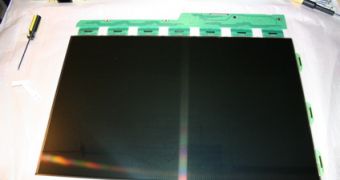Modern LCD displays use thin-flat-transistors (TFT) technology to control the images being shown on the display. However TFT panels are difficult to manufacture because of their large size.
Despite the fact that TFT-based displays have long since became mainstream, they still come with a pretty bulky price tag. However, the new manufacturing process based on inkjet printing might lead to dramatic price drops on the monitor and television markets.
The nowadays LCD manufacturing technology is based on wiring patterns generated using masks. This means that the whole process depends on masks, so any subsequent modifications to the initial design of the LCD display would require completely new masks. Plenty of time and resources are wasted with each transition or upgrade, but the new printing technology seems to be able to fight the above-mentioned shortcomings.
Inkjet printing is also a complicated procedure, since the TFT wiring is performed at an extremely miniaturized scale (2 microns per wire). Currently, the inkjet technology uses ink drops that cannot go below a few picoliters per drop, which would result in an average wire size of at least 20 microns.
However, a paper that is expected to appear later in the Proceedings of the National Academies of Science describes a viable process that uses an extremely customized version of inkjet nozzle, able to spread femtoliter-sized miniature drops that are way smaller than the regular inkjet droplets.
It seems that the whole technology process relies on a special organic solvent mixed with a silver-based ink. The silver nanoparticles are then deposited in micron-sized drops, thus creating a silver wiring structure with both the suitable size and extreme electric conductivity. The solvent is subsequently evaporated using an 130 degrees Celsius oven.
The new process will not completely substitute the masking technology, as the latter will be still used in patterning the substrate gates. However, as the new technology gets perfected, it is alleged that inkjet wiring will become widespread across the LCD manufacturing industry.

 14 DAY TRIAL //
14 DAY TRIAL //